Sisters in Arms: Military Alumnae Find Fulfillment in Uniform
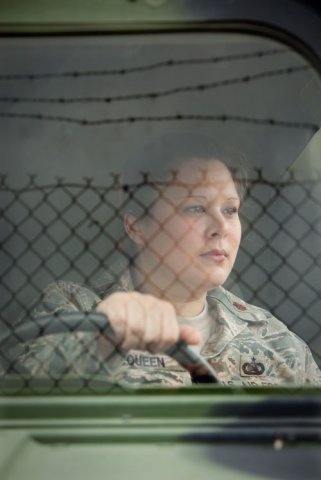
Air Force Major Kimberly Calcutt McQueen ’99 at Robins Air Force Base in Georgia. Photo by Billy Howard
With dust storms swirling above, explosives dropping in the evenings, and the Army rolling in, Air Force Major Kimberly Calcutt McQueen ’99 sat atop Saddam Hussein’s former private terminal at the Baghdad airport in the summer of 2007, maintaining the communications network for Air Force personnel deployed there and preparing to set up communications services for a newly arrived Army battalion. In the next four months she would connect the Iraqi police force with U.S. forces and expand General Petraeus’s communications network.
Despite the danger and pressure of the assignment, McQueen relished the opportunity to use her skills. “The military places a high value on knowledge and advanced education,” says McQueen, “but we spend so much time training that sometimes it’s nice to actually get out there and do the job.”
Despite the training, McQueen admits that she never expected to find herself dodging mortars at the Baghdad Airport,or taking shelter from falling bombs in a bunker before continuing her communications networking tasks.
McQueen confesses that it was the scholarship money offered in exchange for participating in the ROTC unit at UMass that initially drew her into the military. Her plan was to gain a few years of practical experience and retire to the private technology sector. Instead,she says, she found a community where her skills are highly valued, her professional development is encouraged, and she’s given the opportunity to lead.
After ten years in the military, McQueen says it’s a thrill to put on her uniform every day. “I feel empowered. I feel a sense of purpose. Most of all I feel like I’m making a difference in the world,and I can’t imagine a life I’d want more.”
A Life Like No Other
According to a recent Rasmussen Poll, nearly80 percent of Americans now view the US military favorably. Despite the high level of support, if you ask most civilians what life is like in the military, they conjure images only of boot camp and Iraq.
The advent of an all-volunteer service and the elimination of ROTC programs on many private college campuses following the Vietnam War created a gap between military personnel and the average citizen.For Mount Holyoke women in uniform, this gap can feel like a chasm. While their classmates enter civilian careers as lawyers, teachers, and investment bankers,at least three-dozen Mount Holyoke alumnae are currently pursuing professional opportunities in the military.
“If you told me while I was at MHC that I’d end up in the Army, I would have laughed and said you were crazy,” says Army Major Catherine Kimball-Eayrs ’93 (left), who entered Mount Holyoke with dreams of becoming a doctor. After failing to land a spot at one of her top-choice medical schools, she considered her options.
“My dad was a member of the military medical corps, but I never connected the military with a professional career,” she recalls. “After looking into the Uniformed Medical School, I realized that the military could be the path to the career I wanted as a physician.”
Kimball-Eayrs graduated in 1999 with an MD and an Army commission. She expected to complete her required seven years of service in return for her medical degree, leave the military, and work as a civilian physician. Ten years later, she is still in the Army, and is a pediatrician and working mother. Having found increased professional opportunities in the Army, Kimball-Eayrs recently recommitted to another tour.
Beyond the Battlefield
While popular culture associates military life almost solely with combat operations, most military careers happen away from the battlefield. Teams of professionals, from engineers to accountants, provide the infrastructure key to achieving the military’s mission.Others address the challenges of providing everything from health care to groceries for some 1.5 million active-duty personnel and their families.
For example, in her role as director ofbase medical services at NATO Air Base Geilenkirchen, Germany, Air Force Lt.Colonel Melanie Carino ’92 (above) coordinates the care of more than 4,000 U.S.military and government personnel and their dependents.
“I am effectively running a branch of amanaged-care organization,” says Carino, noting that with a budget of over $37billion in 2009, the military healthcare system is one of the largest in the US.
Increased career opportunities for women in traditionally male dominated fields is another benefit of military life,alumnae say. A computer scientist and communications systems specialist, McQueen explains that, because evaluation methods are uniform and focused specifically on the quality of your work, the requirements for advancement are more objective in the military than in civilian jobs.
Says McQueen, “You’re given a tremendous opportunity to shine when you know that your success is based on your performance. That’s exactly the sort of meritocracy I learned to aspire to at Mount Holyoke.”
On the Front Lines
The military’s current strategic plans focus its mission increasingly on humanitarian and peacekeeping missions. From combating yellow fever in Central America to providing relief to the victims of the 2004South Asian tsunami to distributing food aid in Africa, according to the State Department, the U.S. military engages in humanitarian projects in over 100countries in any given year. However, with two wars currently under way, combat operations are still a core element of military life.
Kimball-Eayrs experienced the front lines directly when she deployed to the infamous Iraqi “triangle of death” in September 2006 to provide medical support to an Army combat brigade. The deploymentwas not only an opportunity for Kimball-Eayrs to sharpen her medical skills. As one of 150 women in a group of more than 5,000 and the most senior female, it also offered a chance to demonstrate her leadership abilities.
“You can’t back down in that sort of situation. People are relying on you for more than just your skills; you also need to set an example,” she says. “I drew on the confidence and strength that I developed at Mount Holyoke not only to succeed as the lone female in the group,but also to serve as a leader.”
Finding Work-Life Balance
Day-to-day life in the military can be difficult. Deployments are coming on shorter notice and lasting longer, budget cuts require personnel to do more with less, and duty stations are typically changedevery two to three years, keeping many constantly on the move.
“It’s very hard to commit to staying in the military as a mom,” says Kimball-Eayrs. “You can’t escape the fact that you’re going to be sent away from home for extended periods of time.” In this instance, the equity in performance standards described by McQueen can create an extra burden for soldiers with families. “If you want to get promoted, youneed to do the same things as any other officer; that includes deployments,”says Kimball- Eayrs, whose fourteen-month deployment to Iraq in September 2006came when her children were three years and thirteen months old.
For Major Shawna Doherty ’98 (USAFR),that lack of control over time at home was the primary reason she transferred to the reserves and a civilian job. “I expected to serve a full career in the active-duty military,” says Doherty, who was commissioned as an Air Force officer following her Mount Holyoke and ROTC graduation. Upon returning from a deployment to Afghanistan, Doherty married a civilian and realized that the stability she wantedto build a family wasn’t in the cards if she continued her military career.
Now a consultant, Doherty confesses that the most difficult part of the transition from active-duty to civilian life relates to how she’s viewed as a woman in the workplace. As a military officer, Doherty was guaranteed the respect accorded her rank. As a civilian, she has struggled to achieve that same equality.
Doherty also misses the strong sense of community in the military, and what she describes as a culture focused ondeveloping individuals. “I always felt that I was surrounded by people who wanted me to succeed when I was at Mount Holyoke, and I found the same culture echoed in the military.”
Leaving Mount Holyoke’s Mark
Despite the increasing opportunities for women in the military described by alumnae, there are still chances to break barriers. Women account for just 15 percent of the force, and post- Vietnam-era female officers are only beginning to fill the ranks of generals and admirals.
“Mount Holyoke women have a tremendous opportunity to contribute to shaping military culture, because we’re smart and ambitious,”says Doherty. However, officers must leave personal politics at the door to do their jobs effectively. “Members of the military don’t make policy; that’s up to civilian leaders,” notes McQueen. “Our job is to support those decisions; we implement that policy.” That’s difficult at times for an overachieving Mount Holyoke woman, particularly since the college trains students to advocate for their opinions.
Even though the alumnae interviewed credit their Mount Holyoke education for their military success, on the whole they agree that the MHC community’s support for their career choice is limited.They said professors had refused them recommendations and some classmates and faculty had taunted them for choosing the military. One alumna said a classmatespat on her the day she wore her ROTC uniform to a history class.
Like many private colleges, Mount Holyoke does not maintain an ROTC unit on campus; students wishing to participate join the unit at UMass. Although military representatives do come to campus, some may have been discouraged from recruiting by Mount Holyoke’s policy of asking all organizations recruiting on campus to complete an acknowledgment of nondiscrimination or to discuss with students why they can’t sign the statement. Doherty argues that the lack of support at MHC for military careers limits graduates’ opportunities for jobs and inhibits their understanding of the military. “Members of the military aren’t born in Petri dishes,”she says; “they reflect the values of the communities they come from.”
Answering the Call to Service
Beyond the professional possibilities,alumnae say they serve in the military because they find a sense of honor and purpose in serving their country.
Describing how she was inspired by Mary Lyon’s call to public service, Carino says that she wanted to serve a cause greater than herself. She considered leaving the military several times topursue a larger paycheck in the private sector, but realized that a higher salary would not equal the personal satisfaction of doing a job she describes as important.
“I realized that the culture and the values of the organization were as important to me as the work,” says Carino. Describing the military as a nonprofit organization, she argues that service members give full effort to their jobs not to improve the bottom line, but because so many people rely on them. “In the Air Force we follow a set of core values:integrity first, service before self, excellence in all we do,” says Carino.“Our entire mission is to serve others.”
—By Rachel Kerestes ’99
Rachel Kerestes ’99 is a freelance writer and political consultant. She lives in San Diego with her husband, an officer in the US Navy. This article appeared in the summer 2009 issue of the Alumnae Quarterly.
A-ten-SHUN, MHCers! Here’s More about MHC Alumnae and Other Women in theMilitary
- To sample 1993 MHC alumna Catherine Kimball-Eayrs’s life as a military physician, check out her blog posts in the “comments” section of this article.
- To read previous Quarterly stories about, and see photos of, other alumnae in the military, click here.
- For links to information on women in the US military from the Revolutionary War to oral histories of current servicewomen, click here.
- To read profiles of recent Frances Perkins students who are veterans, click here.
More about MHC Women in the Military
This past April, Sybil Bailey Stockdale ’46 took part in the commissioning ceremony for the missile destroyer Stockdale, a new warship named after her late husband, Vice Admiral James Stockdale. Read the media coverage and see photos here.
http://www.latimes.com/news/local/la-me-stockdale19-2009apr19,0,7641300.story
A piece in the winter1997 Alumnae Quarterly profiled 1994 MHC classmates Fran Mackey and Laurie Shyloski, who had trained at the same Army flight school and had just both beenpromoted to first lieutenant rank. Read the story here.
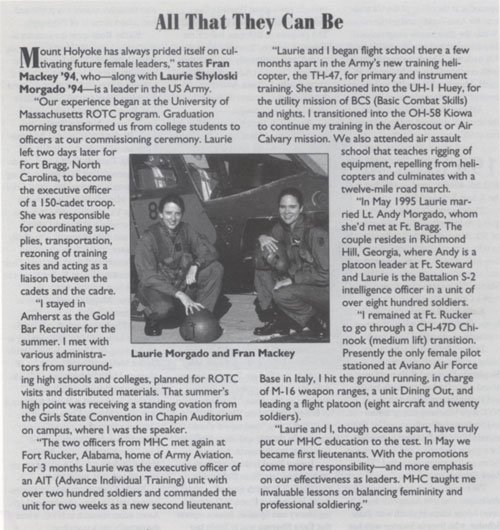
Here’s what they’re up to these days:
Laurie Shyloski Morgado:“My family is currently stationed at Siena College in New York. I left the service just shy of 10 years after I commanded a Blackhawk helicopter company at Fort Hood, Texas. Now my 3 kids—Isabelle 5, Madeleine 4, and Ian, 1—keep me super busy. I look forward to starting another interesting career in a few years.
Fran Mackey Gill: “I ended up spending nine years in the military, where I met my wonderful husband Clair. We have a wonderful two- year-old son, Joshua. I’m just finishing up my intern year as an emergency medicine physician in Richmond,Virginia. It has been a very busy, humbling, incredible journey and I’m trying my best to balance my roles—wife, mother, and physician.”
Heather Lixey ’06 was a ROTC cadet and self-described “Army brat” when the Quarterly interviewed her in 2003for an article about student reactions to the then-new Iraq War. Today she’s a paralegal for the American Red Cross in Washington, DC. Read the summer 2003 Quarterly story here.
Links About Women in the Military
Thanks to Rachel Kerestes’99 for this information.
Women In Military Service For America Memorial Foundation
The history of women in the armed forces began more than 220 years ago with the women who served during the American Revolution, and continues through the present day. The Women’s Memorial honors all the women who have served courageously,selflessly, and with dedication in times of conflict and in times of peace—women whose achievements have for too long been unrecognized or ignored.
http://www.womensmemorial.org/
History Archive of the Women In Military Service For America Memorial Foundation
This site offers an overview of the history of women who have served in or with the US Armed Forces and resources for further study. It also includes hundreds of oral histories.
http://www.womensmemorial.org/H&C/History/historyar.html
Women’s Memorial History Archive
The Women’s Research and Education Institute—Womenin the Military Project
The Women in the Military project was established in 1990 to provide information and policy analysis on issues important to military women and women veterans and to government policy makers,scholars, the media, the media, and the general public. In conjunction with the project’s mission, WREI publishes Women inthe Military: Where They Stand, now in its fifth edition.
Information and analysis is made available to Congress, the executive branch, academia, the media, and members of the public with an interest in military women.
http://www.wrei.org/WomeninMilitary.htm
Government Reports
GAO: Women in the Military—Career Progression Nota Current Problem but Concerns Remain
This report is from 1989and, while dated, it finds no significant impediments to women being promotedat rates similar to men. Civilian and military leaders have since addressed many of the concerns identified in this report.
http://archive.gao.gov/d26t7/139518.pdf
GAO: Gender Issues—Trends in the Occupational Distribution of Military Women (September 1999)
From the report: In 1993 and 1994, significant changes in legislation and policy allowed women to fly combat aircraft, serveon combat ships, and serve in more combat-related occupations. As of September1998, 90 percent of the services’ career fields were open to women, and 80percent of the services’ 1,425,000 positions were open to women. The major areas closed to women include infantry, armor, special forces/SEAL, and submarine warfare. All are associated with ground combat, except submarine warfare, which remains closed due to the cost of changing habitability conditions.
http://www.gao.gov/archive/1999/ns99212.pdf
In these college communications-produced profiles, you’ll meet three Frances Perkins scholars who are veterans.
http://www.mtholyoke.edu/fp/18373.shtml
Read the recent New York Times series on women and the military here. Their “Women at Arms: Valor Under Fire” series “explores how the wars in Iraq and Afghanistan have profoundly redefined the role of women in the military.
August 31, 2009



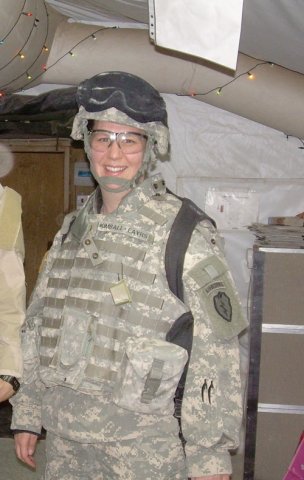
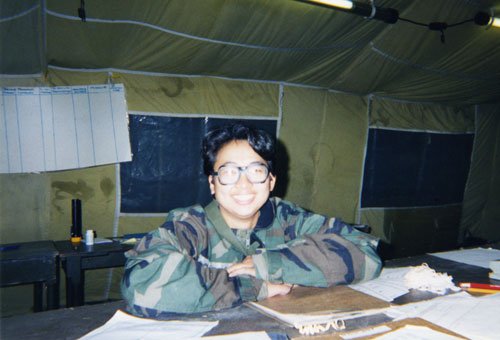
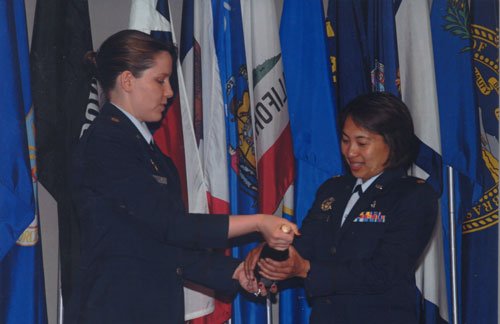






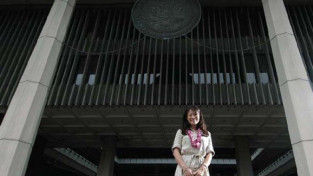


I am baffled at your naivete.
Do you not realize that the very freedoms you exercised in writing your letter (freedom of speech and freedom of the press) come at a price, and it is our military that protects those and other natural and civil/legal rights and liberties?
Thank you for the article about alums in the military. I was embarrassed, but sadly not surprised, to read about the hostility that the women interviewed encountered in the MHC community. While I suspect such open hostility is rare at MHC, disdain for the military is more widespread. The article highlights a couple of critical points: firstly, that soldiers do not choose the wars or other campaigns; and secondly, that they represent a diversity of personalities and ideologies. None of my military friends, for instance, fit the trigger-happy stereotype. There are many ways to serve one's country, but military service is one of the most grueling and dangerous and, I regretfully argue, still necessary. As such, it deserves as much respect as any other career path. It is understandable if a professor has a deep moral objection to promoting the military, despite personal respect for a student recruit. However, before denying something as critical as a recommendation, professors should question whether they are acting merely out of blind prejudice. That being said, my current and former military friends tell me that the article paints an overly sanguine picture of the service. The military, they say, is much more of a patronage system than a meritocracy. For those who were not in ROTC, did not attend a military school such as West Point, and/or do not have the right connections, advancement takes a long time. Superiors treat subordinates arbitrarily based on personal likes or dislikes, and many veterans are denied benefits based on technicalities or unforeseen circumstances. As Major Doherty says, though, MHC alums can try to shape military culture. If alums in the service apply the social sensitivity and awareness of privilege taught at MHC, they can help make the military more of a true meritocracy.
“Greedy hands of the financial elite” – sounds a little trustifarian to me. MHC is what, $52K a year to attend? Who's paying your tuition? Get off your high horse and out of your Prius
I am baffled in reading how women from MHC are finding “fulfillment” and a sense of “service” in our current military pursuits around the globe. Do we not comprehend, as intelligent women, that our “service” is serving only to secure the hold of the greedy hands of the financial elite, whose sole purpose is to obtain and maintain their grip on the oil/natural gas fields and pipelines of Iraq and Afghanistan and the Middle East as a whole?
Do we not also realize that making war (illegally, no less) upon other peoples is one of the most environmentally damaging and polluting activities in which human beings can engage?
How far from Mary Lyon’s intentions will we diverge before we are awakened to ourselves as stewards and protectors of this planet and all its flora and fauna?
I would like to thank the Alumnae Quarterly for its feature on alumnae in the armed forces. As the granddaughter of an Air Force veteran, I understand that these women are serving our country in defense of values we all hold dear, and I respect them for having the courage of their convictions. I do feel, however, that the Quarterly does the entire community a disservice in not sufficiently addressing the barriers to military service faced by many students, faculty, staff, and alumnae, including myself. A brief sentence acknowledging just one reason the armed forces do not recruit on the Mount Holyoke campus seems insufficient in addressing the discrimination against the LGBT community serving in the military. While I honor the principles of the women featured in the article, I also believe the Quarterly has a responsibility to all of its alumnae, including those of us who are prohibited by military policy from honoring these principles. –Liz De Coster ’05
I would like to thank the Alumnae Quarterly for its feature on alumnae in the armed forces. As the granddaughter of an Air Force veteran, I understand that these women are serving our country in defense of values we all hold dear, and I respect them for having the courage of their convictions. I do feel, however, that the Quarterly does the entire community a disservice in not sufficiently addressing the barriers to military service faced by many students, faculty, staff, and alumnae, including myself.
A brief sentence acknowledging just one reason the armed forces do not recruit on the Mount Holyoke campus seems insufficient in addressing the discrimination against the LGBT community serving in the military. While I honor the principles of the women featured in the article, I also believe the Quarterly has a responsibility to all of its alumnae, including those of us who are prohibited by military policy from honoring these principles.
–Liz De Coster ’05
Thank you for the article about alums in the military. I was embarrassed, but sadly not surprised, to read about the hostility that the women interviewed encountered in the MHC community. While I suspect such open hostility is rare at MHC, disdain for the military is more widespread. The article highlights a couple of critical points: firstly, that soldiers do not choose the wars or other campaigns; and secondly, that they represent a diversity of personalities and ideologies. None of my military friends, for instance, fit the trigger-happy stereotype.
There are many ways to serve one's country, but military service is one of the most grueling and dangerous and, I regretfully argue, still necessary. As such, it deserves as much respect as any other career path. It is understandable if a professor has a deep moral objection to promoting the military, despite personal respect for a student recruit. However, before denying something as critical as a recommendation, professors should question whether they are acting merely out of blind prejudice.
That being said, my current and former military friends tell me that the article paints an overly sanguine picture of the service. The military, they say, is much more of a patronage system than a meritocracy. For those who were not in ROTC, did not attend a military school such as West Point, and/or do not have the right connections, advancement takes a long time. Superiors treat subordinates arbitrarily based on personal likes or dislikes, and many veterans are denied benefits based on technicalities or unforeseen circumstances. As Major Doherty says, though, MHC alums can try to shape military culture. If alums in the service apply the social sensitivity and awareness of privilege taught at MHC, they can help make the military more of a true meritocracy.
–Rose Phillips ’05
I am baffled in reading how women from MHC are finding “fulfillment” and a sense of “service” in our current military pursuits around the globe. Do we not comprehend, as intelligent women, that our “service” is serving only to secure the hold of the greedy hands of the financial elite, whose sole purpose is to obtain and maintain their grip on the oil/natural gas fields and pipelines of Iraq and Afghanistan and the Middle East as a whole?
Do we not also realize that making war (illegally, no less) upon other peoples is one of the most environmentally damaging and polluting activities in which human beings can engage?
How far from Mary Lyon’s intentions will we diverge before we are awakened to ourselves as stewards and protectors of this planet and all its flora and fauna?
I would like to thank the Alumnae Quarterly for its feature on alumnae in the armed forces. As the granddaughter of an Air Force veteran, I understand that these women are serving our country in defense of values we all hold dear, and I respect them for having the courage of their convictions. I do feel, however, that the Quarterly does the entire community a disservice in not sufficiently addressing the barriers to military service faced by many students, faculty, staff and alumnae, including myself. A brief sentence acknowledging one reason armed forces do not recruit on the Mount Holyoke Campus seems insufficient in addressing the discrimination against the LGBT community serving in the military. While I honor the principles of the women featured in the article, I also believe the Quarterly has an responsibility to all of its alumnae, including those of us who are prohibited by military policy from honoring these principles.
Patty — Thanks for the comments. I think a memorial would be neat — maybe talking to the alumnae association.
Today I got to unpack my office boxes and start making my new office my own. Starting to feel like I might actually get to work again.
The Army, particularly the Army medical department, is a very small place and one of the benefits is that when you move you often are working with people you knew previously. There are many people here at Walter Reed that I’ve known in “previous lives” and it has been fun seeing them again and catching up. I have had the honor of having two of them ask me to be their child’s pediatrician. What an honor! Really makes it worth it.
Even cooler, I was walking in the hallway today and passed a warrant officer who I recognized and who recognized me at the same time. He was one of our medevac helicopter pilots during my time in Iraq. He had actually gotten pretty sick himself and I had made the decision that he was too sick to stay with us and needed to be evacuated. He wanted to shake my hand and tell me how impressed he was that I had “guessed” his diagnosis. (I really thought he had an infection called Q fever, but had no way to test for it where I was!). He told me that he had ended up in the intensive care unit and ended up spending about 5 weeks out of theater. He was doing great and it was really neat to see him.
Those are the things that make all the troubles worth it.
Thank you so much for your past and present service to our country. My husband is an Army Viet Nam veteran, and my dad served during World War II in the Navy, so I applaud and appreciate your dedication to the volunteer military. Thank you to you AND your family for the tremendous sacrifices you make on a daily basis.
My husband has recently been involved in erecting a plaque at his eating club at Princeton to honor the veteran’s of the Viet Nam War. He remembers seeing plaques for World WarI, World WarII and Korea, but none for any wars after that. I suggested that he also check into vets from his club who served in Desert Storm and Iraq as well. While we were talking about this, I said, “I wonder if any Mount Holyoke alums fought in any wars?” then 2 days later we got the Summer issue of the Quarterly, and there was the article about you, and several other MH military women!!!
The idea then occurred to me, that maybe there should be a plaque or statue or something on campus to commemorate the women of Mount Holyoke who served our country in the mmilitary. What do you think?? Who should I go to with my idea? I grew up in South Hadley, and attended MH from ’68 to ’72, the very years my husband was in Viet Nam (I didn’t know him then…). I really don’t think there is anything on campus that is dedicated to military women. I think it is about time!
I live in Alexandria, VA, right now and would love to go to Walter Reed to meet you!
As I have been commuting in DC traffic this week, I have had ample opportunity to listen to the news and follow the return of the two journalists who have been held in North Korea. I certainly feel for the two women and their families and I am thrilled that they have been reunited. At the same time, as I have listened to reporters comment on their time away and how terrible it is that they have been separated from their families for 150 days, I think about our military families. For many,the MINIMUM they will be separated is 180 days and for most it is at least 365. I will NEVER forget the day I was handed my orders for deployment and at the top they stated “To deploy for 412 or until mission complete.” There is nothing you can say that describes the feeling at the pit of your stomach when you realize you are about to be separated from all those you know and love and to head into danger for that period of time. Interestingly enough, at the time, they were still telling our unit that we would only be deployed for a year. It was only while we were in theater that our deployment got extended. So, while I celebrate the return of the journalists, I do wish that it was not so easy to forget those who serve in our VOLUNTEER military and the sacrifices that they and their families make on a daily basis.
Yesterday was another day for a new experience. Since this is my first week back to work, it is also the first week I have picked up my children from daycare while in uniform. It has been an interesting experience since, in the past, my girls were at a military daycare, so having a parent in uniform was the norm. I have certainly noticed some of the staff looking a little more closely at me, but none had commented. Yesterday, I picked up my younger daughter first. One of her classmates ran into me in the hallway and pointed to my uniform and said “What’s that?”. When I answered that it was my uniform the then asked, “Why are you wearing it?” I then told him that I wear it because I am in the Army. He still looked a little confused, but was willing to take that answer. Then we went to pick up my older daughter and one of her fellow campers asked, “why are you wearing a uniform?” I told her I wear it because I am in the Army. She then asked “Who are the bad guys? Do you hurt the bad guys?” I then explained that I am a doctor and it isn’t my job to hurt the bad guys but to help the soldiers who do. She seemed okay with that, though still a little puzzled looking. One of the teacher’s commented that she thinks they are mostly puzzled because they don’t think of a girl as being able to be in the Army or be a soldier. Hopefully, wearing my uniform is just another way to combat society’s preconceived notions of what a woman can and can’t do.
Well, today was a lot more sitting around and filling out paperwork. (Though one set was well worth filling out since it gets me money back for the move!)
The most striking thing to me about Walter Reed is the sheer number of obviously wounded (seriously wounded)soldiers that you observe just walking through the hospital or across the medical center campus. Anyone that doesn’t think war has a cost should just come sit in the lobby of Walter Reed for a day. The sheer grittiness of these soldiers, and their families, is absolutely humbling. I suddenly had no problem hiking up the stairs in one of the old office buildings . . .because I knew that I could.
So, today was my first day of work at Walter Reed. In the civilian world, that would probably mean a half day or so of getting paperwork done and going to work seeing patients. In the military world, that means I go to one place to pick up paperwork (after taking 30 minutes to find parking and finally parking somewhere not quite legal!), take that paperwork to a different office to pick up more paperwork and then proceed to walk around the hospital (and various other buildings) to “inprocess” which really means everyone has to check you off THEIR list . . .even if they don’t bother to look at the list before you sign off. At one of the stops, I discovered I have a mandatory briefing tomorrow that starts at 0715. A problem since my neither of my daughters’ places of care open prior to 0700. After some shuffling, we determine my husband can take the girls in and go in a little late to work. (Not to different from any dual working family!) I got about half way through my list today . . .not bad considering they give me 10 days to complete it. We’ll see what tomorrow brings. I am definitely ready to getting back to seeing patients!
Hi everyone! This is Catherine Kimball-Eayrs ’93. What an honor to be able to share some of my military life with my fellow alumnae. Currently, I am a general pediatrician in the Army. I’m in the midst of completing a PCS (permanent change of station…we love acronyms in the military) from Madigan Army Medical Center in Tacoma, Washington, to Walter Reed Army Medical Center in Washington, DC.
When I am in the US, my job is to take care of military dependents from newborn to age 23. When I am deployed (which I was from Sept. 2006 to Nov. 2007), I take care of active duty troops. Luckily for me (and really probably for them!) most of them are young, healthy soldiers and so they aren’t too far off my every day practice.
I have the honor of being married to a wonderful man who also happens to be in the Air Force. It does mean that we are often separated. This December, we will have been married for 7 years and by then we will have spent just over 3 years living in the same household. Somehow, we’ve managed to produce two wonderful girls who seem to adjust well to the stresses of having one or other parent gone at any given time. (The other day my four year old declared, “Mommy, now that we are living in our new house with Daddy we are a real family!”).
There are definitely challenges to being in the military, particularly as a woman, and there are times when I think I’m done and can’t do it anymore. But there are some great benefits and, most days, I don’t regret my decision to join the Army to pay for medical school.
I’m happy to answer any questions about my life in the Army (and as an Air Force spouse). My thanks to the Quarterly for providing this opportunity.